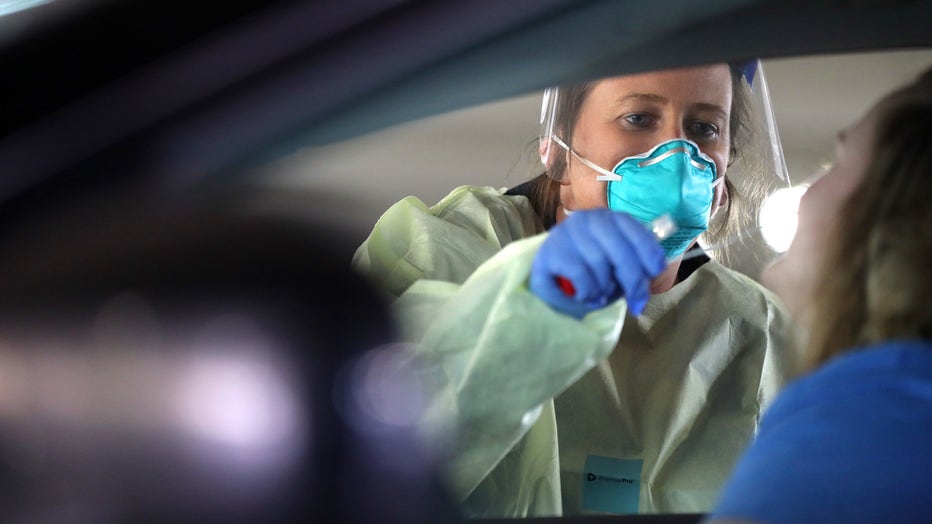Arizona COVID-19 cases rise by over 3K for 4th day in week
PHOENIX - Arizona reported 3,056 additional COVID-19 cases on Thursday, the fourth day in a week in which the state had daily increases of over 3,000 cases.
The state Department of Health Services said the additional cases raised the statewide total to 63,030 with 1,490 deaths, including 27 reported Thursday.
The department reported that a record 2,453 people were hospitalized for COVID-19 as of Wednesday, including 611 in intensive care beds and a record 415 on ventilators.
The hospitalization count was up from 2,270 as of Tuesday.

WESTMINSTER, MARYLAND - MARCH 16: Dawn Canova, clinical manager for outpatient wound care at Carroll Hospital takes samples from people to test them for the coronavirus at a drive-thru station in the hospital's parking garage March 16, 2020 in Westmi
Arizona has become a national hotspot for the coronavirus since Republican Gov. Doug Ducey lifted stay-home restrictions in May.
Health officials have attributed Arizona’s rising number of cases to both increased testing and community spread of the disease.
Ducey last week allowed counties and municipalities to require people to wear face coverings in public, and many have done so, including local governments in metro Phoenix.
For most people, the coronavirus causes mild or moderate symptoms, such as fever and cough that clear up in two to three weeks. But for some — especially older adults and people with existing health problems — it can cause more severe illness, including pneumonia and death.
In order to protect yourself from a possible infection, the CDC recommends:
- Avoid close contact with people who are sick.
- Avoid touching your eyes, nose, and mouth.
- Stay home when you are sick.
- Cover your cough or sneeze with a tissue, then throw the tissue in the trash.
- Clean and disinfect frequently touched objects and surfaces using a regular household cleaning spray or wipe.
- Wash your hands often with soap and water for at least 20 seconds, especially after going to the bathroom; before eating; and after blowing your nose, coughing, or sneezing.
MAP: Worldwide interactive Coronavirus case data
MAP: Arizona Coronavirus cases by zip code
FULL COVERAGE: fox10phoenix.com/coronavirus
Coronavirus (COVID-19)
How it spreads, symptoms, prevention, treatment, FAQ
https://www.cdc.gov/coronavirus
Arizona COVID-19 Response
Public resources, FAQ, webinars
https://www.azdhs.gov/coronavirus
On CoronavirusNOW.com, you'll find extensive coverage about COVID-19, including breaking news from around the country, exclusive interviews with health officials, and informative content from a variety of public health resources.
RELATED:
- How coronavirus differs from flu: Symptoms to watch for
- Is it the flu, a cold or COVID-19? Different viruses present similar symptoms
- Does wearing a face mask protect you from coronavirus and other infectious diseases?
Symptoms for coronavirus COVID-19 include fever, coughing, and shortness of breath. These, of course, are similar to the common cold and flu.
Expect a common cold to start out with a sore or scratchy throat, cough, runny and/or stuffy nose. Flu symptoms are more intense and usually come on suddenly, and can include a high fever.
Symptoms of COVID-19 may appear more slowly. They usually include fever, a dry cough and noticeable shortness of breath, according to the World Health Organization. A minority of cases develop pneumonia, and the disease is especially worrisome for the elderly and those with other medical problems such as high blood pressure, obesity, diabetes or heart conditions.
RELATED: Is it the flu, a cold or COVID-19? Different viruses present similar symptoms
Right now there's one big difference between flu and coronavirus: A vaccine exists to help prevent the flu and it's not too late to get it. It won't protect you from catching the coronavirus, but may put you in a better position to fight it.
To protect yourself, wash your hands well and often, keep them away from your face, and avoid crowds and standing close to people.
And if you do find yourself showing any of these flu or coronavirus symptoms - don't go straight to your doctor's office. That just risks making more people sick, officials urge. Call ahead, and ask if you need to be seen and where.


